UPDATED 9 July 2010
Tank Terror 2: Weak Men Want Big Tanks
By Mike Sparks
We saw in Part 1 that American infantry refused to light mechanize and found that the towed anti-tank (AT) guns they wanted to man-handle were soon out-classed by German tanks whose armor was impervious to their puny shells at places like the Kasserine Pass and Cisterna in 1943. At the end of WW2, they opted for the recoilless, hand-held bazooka as a solution-to-everything (AT panacea) before having their asses handed to them again in South Korea when Task Force Smith was over-run by North Korean T34/85 medium tanks. They finally got their act together thanks to LTG James Gavin with the M113 light tracked tank chassis but emasculated themselves into fatally weak Humvee trucks in "light" units and bloated Bradleys with 50% Gavins in "heavy" units in the 1980s. American infantry is getting creamed regularly today in Iraq/Afghanistan by their non-adaption. The whole point of being MOBILE with tracks is to be able to surprise the enemy when you hit him, and to run his obstacles over if he resists as depicted well in the 007 movie Goldeneye with an upgraded T62 Russian MEDIUM tank.
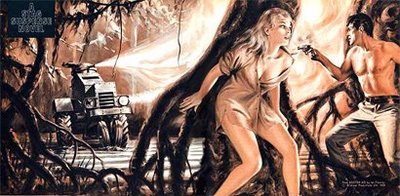
 www.youtube.com/watch?v=WegooUvYoj0
www.youtube.com/watch?v=WegooUvYoj0
American infantry has M113 Gavin LIGHT tanks to do these things today but not in its LIGHT Infantry Brigade Combat Teams which foot-slog and truck-hop into land mines on roads/trails.
 www.youtube.com/watch?v=6mFmOR01Gfg
www.youtube.com/watch?v=6mFmOR01Gfg
The other avenue of post-WW2 bureaucratic excuse was to foist the AT mission off on Armor branch who never wanted to fire support for the slow-marching infantry in the first place that has embraced heavier and heavier tanks to duel other enemy tanks--mirror images of themselves--becoming the defacto TANK DESTROYER branch that was earlier abolished.
This is a tale of weak men wanting BIG tanks.
This institutional Lowest Common Denominator (LCD) attitude is exactly why the young Ian Fleming after Sandhurst refused to join the mechanized British Army and instead became the 2IC of British Naval Intelligence reaching the rank of Commander by war's end. We know he valued enlightened mechanization to BUILD UPON INDIVIDUAL INITIATIVE STRENGTH from his James Bond novels and movies where Agent 007's car has many weapons and devices and from his children's book, Chitty, Chitty, Bang, Bang where the hero-inventor's car flies. Years later, a flying car was featured in the movie adaptation of Fleming's The Man with the Golden Gun.
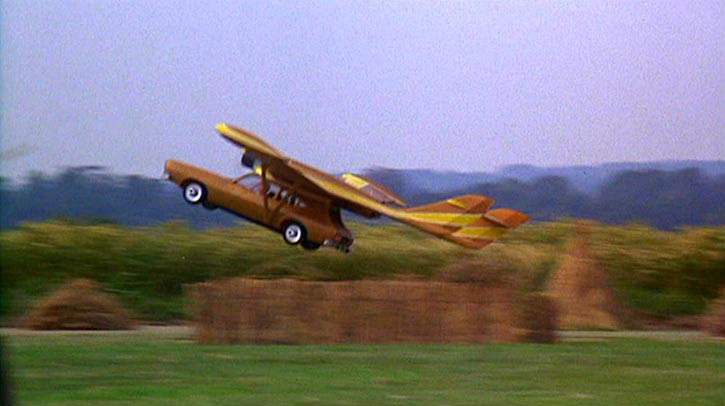
 www.youtube.com/watch?v=SwHqLtK_TpY
www.youtube.com/watch?v=SwHqLtK_TpY
In fact, this is where land warfare needs to go: TANKS MUST FLY.
It all tracks (pun intended) back to Ian Fleming.
U.S. "Armor" Doctrine in WW2
Idea 1 that infantry needs a FIRE SUPPORT tank that can break-through enemy fortifications is a good one.
That this tank would be a HIGH-PROFILE TURRETED medium tank with bad mobility is a BAD EXECUTION. The Germans used turret-less STUG LIGHT tanks to act as assault guns for their infantry and were extremely successful. The turret is a weak spot and makes the vehicle easy to spot and hit. The "Jumbo Shermans" where heavy armor was slapped on front was a good idea, but you could slap this same amount or even more on a SMALLER, LOW PROFILE TURRETLESS tank.
 www.youtube.com/watch?v=NT-8X2JOcAc
www.youtube.com/watch?v=NT-8X2JOcAc
Idea 2 that after the breakthrough, fire support tanks would help infantry is a good one as long as we realize that if they are WALKING we are exactly like the slow British Mathilda and Churchill tanks. DO WE WANT THIS? Why not put the infantry in its own turretless tanks, even open-topped like the fully-tracked M39 AUV or M3 half-track?
Yes, we did that.
However, once through the lines, our fire support tanks ran into HARD shell German tanks and couldn't penetrate them because their guns were designed to blast SOFT enemy bunkers/dug-in positions with medium-velocity shells creating high explosive blasts. When confronted with this fatal weakness conceptually, U.S. force planner, artilleryman LTG Lesley McNair created "tank destroyer" units which would shoot the high velocity anti-tank guns needed to duel and then bust German tanks. TD units had both towed and self-propelled AT guns, though penny-pincher, McNair would have had everything towed if he could.
The problem was TD units wouldn't be there when the Sherman fire support tanks encountered them; the chess piece mentality of skimping on capabilities by having only a separate unit handle a problem has been proven again and again to fail: TF Smith didn't take their M24 Chaffee light tanks to South Korea and were over-run by T34/85 medium tanks, the marines didn't mechanize themselves in AAV-7 amtracks into an area defense but instead clusterfucked into one building which was blown up by a suicide truck bomber.
So finally it dawns on us Americans that the medium tank we have been mass-producing has to be able to do both infantry fire support and duel other tanks--but we are having troubles replacing the weak 75mm gun with a more powerful AT gun in the cramped M4 Sherman turret.
NOTE: Wiki notes: "In the United Kingdom the M4 was given the name Sherman after Union General William Tecumseh Sherman, following the British practice of naming their American-built tanks after famous American Civil War generals. Subsequently the British name found its way into common use in the U.S."
So the fact that we call our M113s, "Gavins" is no different today. No one has to wait for the idiotic USMIL bureaucracy to "see the light".
U.S. Arrogance refuses British 17-Pounder Gun Help
Fortunately, the brighter British already figured this out and had fitted 17-pounder (76.2mm) anti-tank guns to create "Firefly" Sherman medium tanks in SOME of their tanks while keeping others with 75mm guns for softer enemy infantry targets. It worked wonders throughout the war. The British offered their 17-pounder to us Americans and we said "NO!" by deceitful tests with our 90mm anti-aircraft gun WHICH COULDN'T EVEN FIT INTO A SHERMAN TURRET.
A black mark for the otherwise "Greatest Generation".
Instead, we go for the less capable 76mm and many men burn up in our Shermans creating the "Tiger tank" terror resulting in us going hog wild for a heavy tank of our own, the 70-ton M1 Abrams in the 1980s.
However, the question has to be asked---HOW MANY BRITISH 17-POUNDER GUN EQUIPPED FIREFLY TANKS WERE KNOCKED OUT BY GERMAN TANKS?
I bet you, not very many.
In fact when "007" Tiger heavy tank ace commander Michael Whittman went on a rampage against lesser British tanks near Caen, it was Commander Ian Fleming who dispatched British Armor Soldiers in Firefly Shermans with 17 pounder guns that ended his "license to kill"--not non-esistent M26 Pershing heavy tanks...
So all of this reactive whining that the Sherman tank was "too light and under-armored" (protection) as a medium tank is INCORRECT; the PROBLEM WAS ITS GUN (firepower) couldn't take-out the enemy's tanks. In fact, the M18 Hellcat light (mobility) tank destroyer with the slightly improved 76mm gun was even less armored than Shermans--but would sprint into firing positions where it could destroy the German medium to heavy tanks by flank and rear shots where their armor was thinner. Had the 17-pounder or 90mm gun been fitted to the Hellcat, even the sprinting wouldn't have been necessary....
So the key in anti-tank warfare is having the gun FIREPOWER necessary to destroy the enemy's tanks; NOT being invulnerable to their fire by heavy armor. By placing a turbine engine in the Abrams heavy tank we Americans thought we could keep our invulnerability to enemy main gun fire and at the same time have M18 Hellcat sprint capabilities AKA the American folk saying of unrealistic demands: "have your cake and eat it, too". The consequence being they burn up so much fuel, that after a breakthrough is made say from Saudi Arabia into Iraq in 1991, it cannot be exploited because they have to constantly stop to refuel which resulted in the Republican Guard escaping to keep dictator Saddam Hussein in power for another decade.
www.combatreform.org/heavytankshelicopters.htm
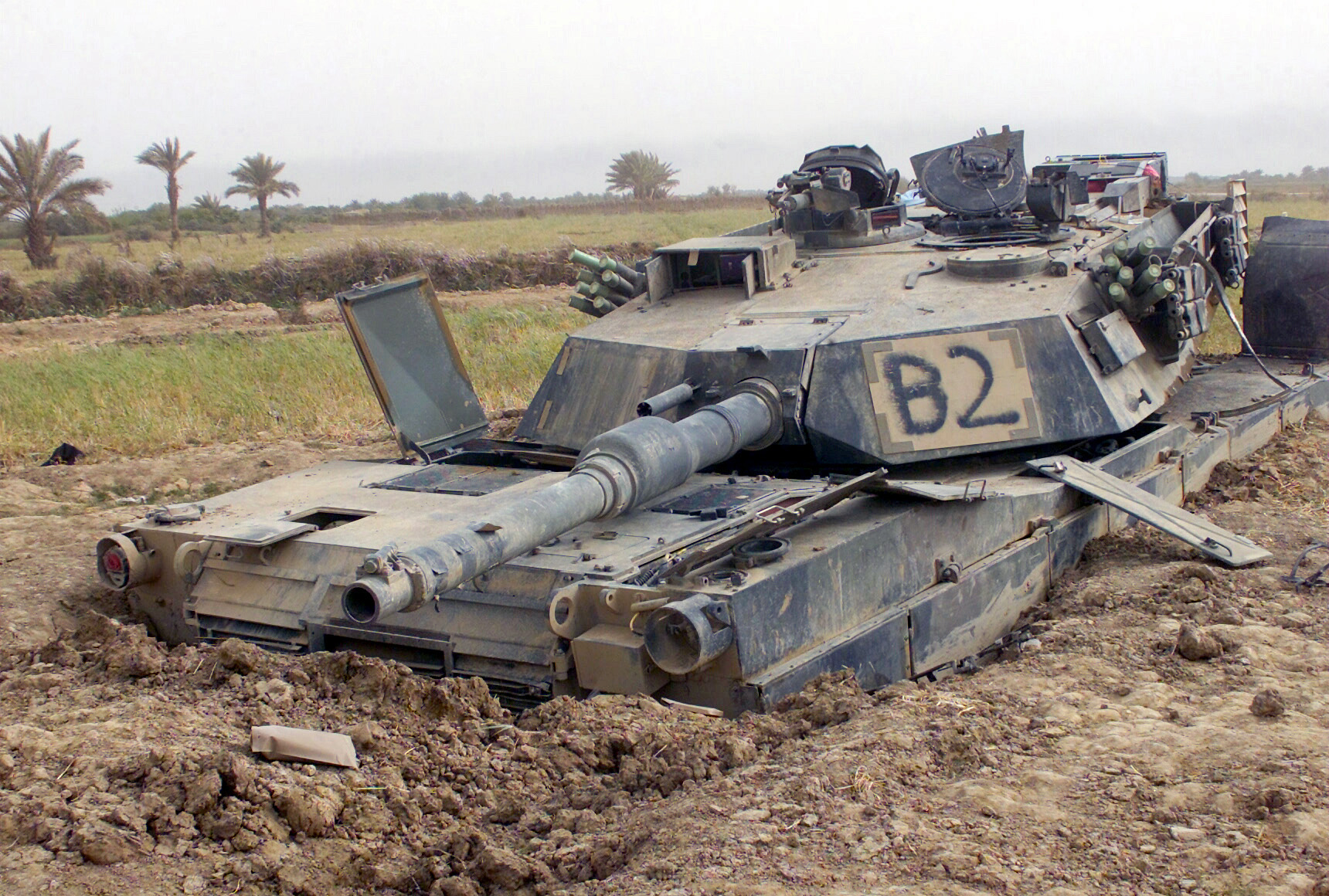
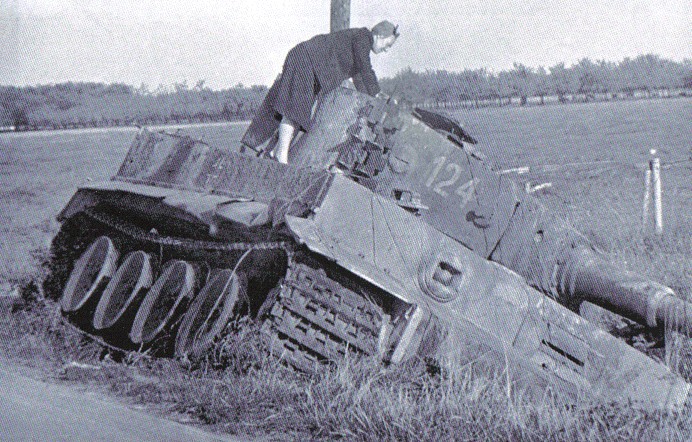
M1 Abrams heavy tank stuck in Iraq; German Tiger heavy tank stuck in WW2: See the Similarities?
U.S. Armor branch Tiger tank and Soviet tank horde paranoia had created the "MECH PUSSY"; the whoppertanktard who only wants to DUEL OTHER TANKS who has totally abrogated his MANEUVER mission to breakthough enemy lines and then exploit this to win battles and wars. Armor branch today is really TANK DESTROYER branch. We didn't abolish tank destroyer branch, it MORPHED into Armor branch.
Even today, while one gun barrel can be used to take out both hard and soft targets, its REQUIRES TWO DIFFERENT TYPES OF AMMUNITION to do it. The Abrams only carries 44 rounds and most of these are AT types, so who suffers from the lack of HE fire support?
Of course, the narcissistic, light infantry! Who wants SOMEONE ELSE to operate tanks for him--lest it cut into his PT/marksmanship/battle drills Luddite mantra of simplistic war that subsidizes his "From Here to Eternity" racket.
The laws of physics are the laws of physics. We'd be much better prepared to win wars if we had turret-less light tank ASSAULT GUNS who carry lots of HE and smokescreen shells to help the infantry with some AT shells for emergency use and medium TANK DESTROYERS that can get rid of enemy tanks and sip on fuel to enable exploitations than the current homogenized heavy-tank-for-everything manned by cowards who only want to participate in wars where they duel other enemy tanks from invincibility. How many Abrams do we have operating in the sub-national conflict of mountainous/desert Afghanistan?
[Hint: its less than 1...don't strain yourself too much trying to come up with an answer!]
Bye, Bye Obstructionist McNair!
Saddled with all our bureaucratic BULLSHIT we find ourselves pinned down in the French hedgerows by mere enemy infantry--while to the east, in General Montgomery's sector of the Normandy landings has to duel it out with German tanks which thankfully, they are prepared to deal with BEFOREHAND by having 17-pounder Firefly Sherman tanks. GET-IT, DRIVE-ON (GIDO) beats FUCK-IT, DRIVE-ON (FIDO).
Someone gets the bright idea to mass our heavy bombers and carpet bomb ahead as a clever TSGT named "Cullins" creates a hedgerow cutter so General Patton's 3rd Army can bust out and do an end around the Germans to help "Monty". Typical Americans relying on air power as a crutch for ground maneuver weakness.
www.combatreform.org/sappertanks.htm
Operation COBRA
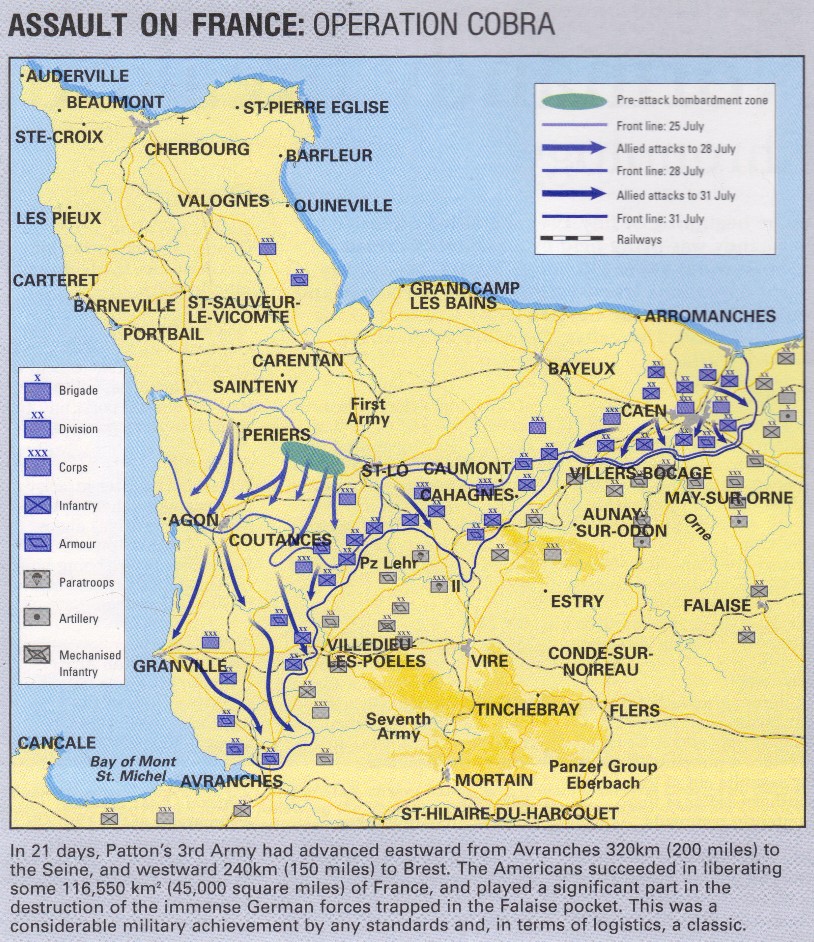
[From the EXCELLENT book, Campaigns of World War II Day-by-Day by Chris McNab and Chris Bishop--I highly recommend it!
During this bombardment, an errant bomb lands on LTG McNair IN A FIGHTING HOLE (!) near the pre-bombardment zone, making him the highest-ranking American to die in WW2. The irony is that if he was in a fully-enclosed, tracked, armored vehicle--he probably wouldn't have died. Gone with him was the obsession with towed AT guns and obstructionism to 90mm guns on tank destroyers and the upcoming M26 Pershing heavy tank. It makes one wonder if his demise wasn't a "fragging" incident.
Patton broke out and almost bagged the entire German Army in France...but Rockefeller Illuminati man General Eisenhower let them escape to prolong the war--and profits.
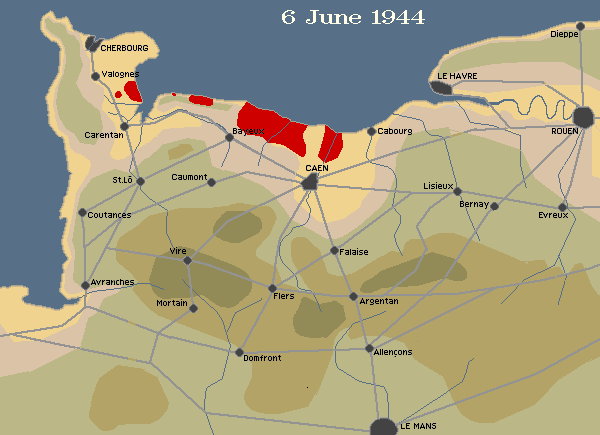
Wet Ammo Storage
An interesting technique is to have your gun ammo stored by water so if hit by enemy fire it doesn't ignite--a great idea we should incorporate in our tanks as water for Soldiers to wash with.
NOTES
http://en.wikipedia.org/wiki/M4_Sherman
M4 Sherman
From Wikipedia, the free encyclopedia
This article includes a list of references or external links, but its sources remain unclear because it has insufficient inline citations. Please help to improve this article by introducing more precise citations where appropriate. (April 2009)
Medium Tank M4
An M4A3E8 76mm armed Sherman tank made during the Second World War
Type Medium tank
Place of origin United States
Service history
In service 1942-1955 (USA)
Used by United States and many others, see Foreign variants and use
Wars World War II, Greek Civil War, Arab-Israeli War, Korean War, Suez Crisis, Indo-Pakistani War of 1965, Six-Day War, Indo-Pakistani War of 1971, Yom Kippur War
Production history
Designed 1940
Produced 1941-
Number built 50,000+
Specifications
Weight 66,800 pounds (30.3 tonnes; 29.8 long tons; 33.4 short tons)
Length 19 ft 2 in (5.84 m)
Width 8 ft 7 in (2.62 m)
Height 9 ft (2.74 m)
Crew 5 (Commander, gunner, loader, driver, co-driver)
--------------------------------------------------------------------------------
Armor 63 mm
Primary
armament 75 mm M3 L/40 gun 90 rounds
Secondary armament .50 cal Browning M2HB machine gun (300 rounds),
2 × .30-06 Browning M1919A4 machine guns (4,750 rounds)
Engine Continental R975 C1 gasoline
400 hp (298 kW) gross at 2,400 rpm
350 hp (253 kW) net at 2,400 rpm
Power/weight 15.8 hp/tonne
Transmission Spicer[2] manual, synchromesh,[3] 4 forward (plus 1 overdrive)[4] and 1 reverse gear
Suspension Vertical Volute Spring Suspension (VVSS)
Operational
Range 120 miles at 175 U.S. ga (193 km at 660 l; 80 octane)
Speed 25 to 30 mph (40 to 48 km/h)[1]
The M4 Sherman, formally Medium Tank, M4, was the primary tank used by the United States during World War II. It was also distributed to the Allies via lend-lease. Evolved from previous medium and light tanks, it was the first American medium tank with the main gun mounted on a fully traversing turret.
Production of the M4 medium tank exceeded 50,000 units and its chassis served as the basis for numerous other armored vehicles such as tank destroyers, tank retrievers, and self-propelled artillery. Only the Soviet T-34 tank was produced in larger numbers.
In the United Kingdom the M4 was given the name Sherman after Union General William Tecumseh Sherman, following the British practice of naming their American-built tanks after famous American Civil War generals. Subsequently the British name found its way into common use in the U.S.
The original Shermans were powerful enough to defeat the German tanks they faced when first deployed in North Africa. But later, the Shermans were often pitted against Tiger I and Panther tanks, which had heavier armor and more powerful guns, and the U.S. tanks had to rely on numbers and mobility, often suffering heavy casualties.
America's most advanced tank of the war was the M26 Pershing, but it was developed too late to play a significant role, as the U.S. emphasized volume production of more Shermans. Post-war tank development built upon the M26, but the Sherman and its variants continued to be used in training and combat into the late 20th century.[5]
Contents [hide]
1 U.S. design prototype
2 U.S. production history
3 Service history
4 Armament
4.1 The tank destroyer doctrine
4.2 Gun development
4.3 Miscellaneous
5 Armor
6 Mobility
7 U.S. variants
8 Foreign variants and use
9 See also
10 Notes
11 References
12 External links
U.S. design prototype
A cutaway showing the internal arrangement of an M4A4 Sherman.The U.S. Army Ordnance Department designed the Medium Tank M4 as a replacement for the M3 Medium. The M3 was an up-gunned development of the M2 Medium Tank of 1939, itself derived from the M2 Light Tank of 1935. The M3 was developed as a stopgap measure until a new turret mounting a 75 mm gun could be devised, and suffered from a number of design faults, mainly a large silhouette, and an inflexible side sponson mounting for the main gun, which could not be aimed across the side on which it was mounted.
Detailed design characteristics for the M4 were submitted by the Ordnance Department on 31 August 1940, but development of a prototype had to be delayed while the final production designs of the M3 were finished, and the M3 entered full-scale production.
On 18 April 1941 the U.S. Armored Force Board chose the simplest of five designs. Known as the T6, the design was a modified M3 hull and chassis, carrying a newly designed turret mounting the Lee's main gun. This became the Sherman.[6]
Sherman medium tank of World War II, the workhorse of U.S. armored forces
The Sherman's reliability benefited from many design features first developed in U.S. light tanks during the 1930s, including vertical volute spring suspension, rubber-bushed tracks, and rear-mounted radial engine with drive sprockets in front. The designated goals were to produce a fast, dependable medium tank able to support infantry, provide breakthrough striking capacity, and defeat any tank currently in use by the Axis nations.
The prototype M4 was completed on 2 September 1941. Unlike later M3s, the hull was cast. It had a side hatch which was eliminated from production models. The T6 became standardized as the M4, and production began in October 1941.[7]
U.S. production history
See also: American armored fighting vehicle production during World War II
The U.S. Army had seven main sub-designations for M4 variants during the production period: M4, M4A1, M4A2, M4A3, M4A4, M4A5, and M4A6. These designations did not necessarily indicate linear improvement: for example, A4 is not meant to indicate 'better than' A3. These sub-types indicated standardized production variations, which were in fact often manufactured concurrently at different locations. The sub-types differed mainly in engines, although the M4A1 differed from the M4 by its fully-cast upper hull rather than by engine; M4A4 had a longer engine system that required a longer hull, a longer suspension system, and more track blocks; M4A5 was an administrative placeholder for Canadian production; and M4A6 had an elongated chassis, but fewer than 100 of these were produced.
While most Shermans ran on gasoline, the M4A2 and M4A6 had diesel engines: the M4A2 with a pair of GMC 6-71 straight six engines,[8] the M4A6 a Caterpillar RD1820 radial.[9] These, plus the M4A4 which used the Chrysler A57 multibank engine, were mostly supplied to Allied countries under Lend-Lease.[10] "M4" can refer specifically to the initial sub-type with its Continental radial engine, or generically, to the entire family of seven Sherman sub-types, depending on context. Many details of production, shape, strength, and performance improved throughout production without a change to the tank's basic model number; more durable suspension units, safer "wet" (W) ammunition stowage, and stronger armor arrangements, such as the M4 Composite, which had a cast front hull section mated to a welded rear hull. British nomenclature differed from that employed by the U.S.
A 24-volt electrical system was used in the M4.[11]
M4 Sherman: comparison of key production features of selected models Designation Main Armament Hull Engine
M4(105) 105 mm howitzer welded gasoline Continental R975 radial
M4 Composite 75 mm cast front welded sides gasoline Continental R975 radial
M4A1(76)W cast gasoline Continental R975 radial
M4A2 75 mm welded diesel GM 6046 (2x6-71 inline)
M4A3W 75 mm welded gasoline Ford GAA V8
M4A3E2 "Jumbo" 75 mm (some 76 mm) welded gasoline Ford GAA V8
M4A3E8(76)W "Easy Eight" 76 mm welded gasoline Ford GAA V8
M4A4 75 mm welded lengthened gasoline Chrysler A57 5x6-cyl inline
M4A6 75 mm cast front welded sides lengthened diesel Caterpillar D200A radial
Early Shermans mounted a 75mm medium-velocity general-purpose gun. Although Ordnance began work on the Medium Tank T20 as a Sherman replacement, ultimately the Army decided to minimize production disruption by incorporating elements of other tank designs into Sherman production. Later M4A1, M4A2, and M4A3 models received the larger T23 turret, with a high-velocity 76 mm gun M1, which reduced the number of HE and smoke rounds carried and increased the number of anti-tank rounds. Later, the M4 and M4A3 were factory-produced with a 105mm howitzer and a new distinctive mantlet in the original turret. The first standard-production 76 mm gun Sherman was an M4A1, accepted in January 1944, and the first standard-production 105 mm howitzer Sherman was an M4 accepted in February 1944.
In June-July 1944, the Army accepted a limited run of 254 M4A3E2 Jumbo Shermans, which had very thick armor, and the 75mm gun in a new, heavier T23-style turret, in order to assault fortifications. The M4A3 was the first to be factory-produced with the HVSS (horizontal volute spring suspension) suspension with wider tracks to distribute weight, and the smooth ride of the HVSS with its experimental E8 designation led to the nickname Easy Eight for Shermans so equipped. Both the Americans and the British developed a wide array of special attachments for the Sherman; few saw combat, and most remained experimental. Those which saw action included the bulldozer blade for Sherman dozer tanks, Duplex Drive for "swimming" Sherman tanks, R3 flame thrower for Zippo flame tanks, and the T34 60-tube Calliope 4.5" rocket launcher for the Sherman turret. The British variants (DD's and mine flails) were among "Hobart's Funnies," named after their commander, Percy Hobart of the 79th Armoured Division.
The M4 Sherman's basic chassis was used for all the sundry roles of a modern mechanized force: roughly 50,000 Sherman tanks, plus thousands more derivative vehicles under different model numbers. These included M32 and M74 "tow truck"-style recovery tanks with winches, booms, and an 81 mm mortar for smoke screens; M34 (from M32B1) and M35 (from M10A1) artillery prime movers; M7B1, M12, M40, and M43 self-propelled artillery; and the M10 and M36 tank destroyers.
Service history
See also: Lend-Lease Sherman tanks
First type in U.S. service: A U.S. 7th Army M4A1 lands at Red Beach 2, Sicily on July 10, 1943 during the Allied invasion of Sicily.
Last type in U.S. service: M4A3E8 Sherman used as artillery position during the Korean War
M4A3E8 participating in a World War II victory paradeThe M4 Sherman served with the U.S. Army and Marine Corps during World War II. The U.S. also supplied large numbers to the various Allied countries. Shermans were used during the war by British and Commonwealth armies, the Soviet Union's Red Army, Free French forces, the Polish army in exile, China's National Revolutionary Army, and Brazil's Expeditionary Force.
The U.S. marine corps used the diesel M4A2 and gasoline-powered M4A3 in the Pacific. However, the Chief of the Army's Armored Force, Lt. Gen. Jacob L. Devers, ordered that no diesel-engined Sherman tanks be used by the Army outside the Zone of Interior (the continental U.S.). The U.S. Army used all types for either training or testing within the United States, but intended the M4A2 and M4A4 to be the primary Lend-Lease exports.
The M4A1 Sherman first saw combat at the Second Battle of El Alamein in October 1942 with the British 8th Army. The first U.S. Shermans in battle were M4A1s in Operation TORCH the next month. At this time, Shermans successfully engaged German Panzer IIIs with long barreled 50mm L60 guns, and Panzer IVs with short barreled 75 mm L24 guns. Additional M4 and M4A1s replaced M3 Lees in U.S. tank battalions over the course of the North African campaigns. However, by June 1944, most German tanks were up-gunned and 75 mm Shermans were out-gunned. The M4 and M4A1 were the main types in U.S. units until late 1944, when the Army began replacing them with the preferred M4A3 with its more powerful 500 hp (370 kW) engine. Some M4s and M4A1s continued in U.S. service for the rest of the war.
The first Sherman to enter combat with the 76 mm gun (July 1944) was the M4A1, closely followed by the M4A3. By the end of the war, half the U.S. Army Shermans in Europe had the 76 mm gun. The first HVSS Sherman to see combat was the M4A3E8(76)W in December 1944.
After World War II, the U.S. kept the M4A3E8 "Easy Eight" in service with either the 76 mm gun or a 105 mm howitzer. The Sherman remained a common U.S. tank in the 1950-1953 Korean War, but the Army replaced the Shermans with Patton tanks during the 1950s. The U.S. continued to transfer Shermans to its allies, which contributed to wide foreign use worldwide.
Armament
The gun on the original M4 was the short-barreled medium-velocity 75mm M3 gun. When the Sherman first saw combat in North Africa in late 1942 against Panzer III and Panzer IV tanks, its gun could penetrate the armor of these tanks at normal[clarification needed] combat ranges. [citation needed]
U.S. Army Intelligence discounted the arrival of the Tiger I in late 1942 and the Panther tanks in 1943, predicting that they would be produced only in small numbers. The U.S. Army failed to anticipate that the Germans would make the Panther the standard tank of their panzer divisions in 1944, supported by substantial numbers of Tigers.[12]
As a result, the Bureau of Ordnance, which had developed new 90mm and 76mm anti-tank guns in 1943, didn't provide U.S. armored forces with the guns required to optimally fight the Panther and Tiger. Even in 1943, most German AFVs (later models of the Panzer IV, StuG III, and Marder III) mounted 7.5 cm KwK 40. As a result, even weakly-armored light German tank destroyers such as Marder III, which was meant to be a stop-gap measure to fight Soviet tanks in 1942, could destroy Shermans from a distance. The disparity in
The tank destroyer doctrine
Gen. Lesley J. McNair was head of Army Ground Forces. McNair, an artilleryman, pushed the tank destroyer doctrine within the U.S. Armored Forces. Tanks were to support the infantry, exploit breakthroughs, and avoid tank-to-tank battles. Enemy tanks were to be engaged by the tank destroyer force, composed of a mix of towed and self-propelled tank destroyers. Towed "tank destroyers" were towed antitank guns. Self-propelled tank destroyers, called "motorized gun carriages", were similar to tanks but were lightly armored with open-topped turrets. The tank destroyers were supposed to be faster and carry a more powerful anti-tank gun than tanks; armor was sacrificed for speed. The tank destroyer doctrine played a large role in the lack of urgency in improving the firepower of the M4 Sherman, as the emphasis was on its role as infantry support.[16]
McNair approved the 76mm upgrade to the M4 Sherman and production of the 90mm M36 tank destroyer, but he staunchly opposed development of the T26 and other proposed heavy tanks during the crucial period of 1943 because he saw no "battle need" for them.
In mid-1943, Lt. General Devers, now commander of U.S. forces in the European Theater of Operations, asked for 250 T26s for use in the invasion of France. McNair refused. Devers appealed to General George Marshall, the Army Chief of Staff. Marshall summarily ordered the tanks to be provided to the ETO as soon as they could be produced. Soon after the Normandy invasion, General Eisenhower urgently requested heavy tanks (now designated M26 Pershing), but McNair's continued opposition delayed production. General Marshall intervened again and the tanks were eventually brought into production. But combat use of the M26 was delayed until almost the end of the war. A few entered combat on February 25, 1945, too late to have any effect on the battlefield.[17]
Gun development
This M4A2(76) HVSS shows the T23 turret with later 76mm gun's muzzle brake. This one also has fenders, usually omitted on U.S. vehicles to ease maintenance.
Although tests against armor plate suggested that the new M1A1 76mm gun would be adequate,
The 90mm gun developed by U.S. Ordnance could not be easily installed on the M4, but was installed on the open turreted M36 tank destroyer, and was the main gun for the T26 tank project (which eventually became the M26 Pershing).
In testing prior to the invasion of Normandy, the new 76mm gun on the M4 Sherman was found to have a undesirable muzzle blast that kicked up dust from the ground and obscured vision for further firing. The addition of a muzzle brake directed blast sideways to solve this problem. It also had a much weaker high explosive shell than the existing 75mm gun. Standard Army doctrine at the time emphasized the importance of the infantry support role of the tank, and the high explosive round was considered more important. Hence the 76mm M4 was not initially accepted by various U.S. Armored Division commanders, even though a number had already been produced and were available. All of the U.S. Army M4s deployed initially in Normandy in June 1944 had the 75mm gun.[21]
The British were more astute in their anticipation of the future development of German armor. They mounted their high-powered Ordnance QF 17-pounder gun in a standard 75 mm M4 Sherman turret. These conversions became the Sherman Firefly
In late 1943, the British offered the 17 pounder to the U.S. Army for use in their M4 tanks
Fighting against Panther tanks in Normandy quickly demonstrated the need for better anti-tank firepower, and the 76mm M4s were deployed to First Army units in July 1944. Patton's Third Army were initially issued 75 mm M4s and accepted 76mm M4 Shermans
High Velocity Armor Piercing (HVAP) ammunition, standardized as M93, became available in August 1944 for the 76mm gun. The projectile contained a tungsten core penetrator surrounded by a lightweight aluminum body, which gave it a higher velocity and more penetrating power. However, this new projectile was still unable to penetrate the glacis plate of the Panther tank although it could penetrate the turret mantlet of the Panther at longer ranges than standard ammunition; it brought the U.S. 76 mm gun closer in performance to the British 17 pounder using standard APC ammunition.
After the heavy tank losses of the Battle of the Bulge
Additionally, interest in mounting the British 17 pounder in U.S. Shermans flared anew. In February 1945, the U.S. Army began sending 75 mm M4s to England for conversion to the 17 pounder gun. Approximately 100 tanks were completed by the beginning of May
The higher-velocity 76mm M1 gun gave Shermans anti-tank firepower at least equal to most of the German vehicles they encountered, particularly the Panzer IV, and StuG. However, with a regular AP (Armor Piercing shot) ammunition (M79) or APCBC (M62) shells, the 76mm might knock out a Panther
The M4 was criticized by its crews for inability to pivot turn (turn in place), limiting its usefulness in urban warfare against pivot turning Panthers
Miscellaneous
A USMC M4A3R3 uses its flame thrower armament during the Battle of Iwo Jima.In the relatively few tank battles of the Pacific War, even the 75 mm gun Shermans outclassed the Japanese Type 95 Ha-Go light and Type 97 Chi-Ha medium tanks, which were 1930s designs. High explosive ammunition was preferred because armor-piercing rounds went right through the thin armor of a Japanese tank and often out the other side without necessarily stopping it. Although the high-velocity guns of the tank destroyers were useful for penetrating fortifications, Shermans armed with flamethrowers also were used to destroy Japanese fortifications. There were several types of flamethrowers, differing primarily in the type and location of the projector.
The Sherman was one of the first widely produced tanks to feature a gyroscopic stabilized gun and sight. The stabilization was only in the vertical plane, as the mechanism could not slew the turret. The utility of the stabilization is debatable, with some saying it was useful for its intended purpose, others only for using the sights for stabilized viewing on the move.[30]
A variant of the M4 Sherman was armed with the 105 mm M4 howitzers, which provided even more powerful high-explosive armament. However, they were of limited use in fighting enemy tanks due to the poor anti-armor performance of the howitzer, which was not intended to fight other tanks.
The 75 mm gun had a white phosphorus shell originally intended for use as an artillery marker to help with targeting. M4 tank crews discovered that the shell could also be used against German Tiger and Panther tanks - when the burning white phosphorus splattered against the German tank, the acrid smoke would get sucked inside the tank, and together with the fear of the fire spreading inside the tank, cause the crew to abandon the tank.[31] There were several recorded instances where white phosphorus shells "knocked out" German tanks in this fashion.[32]
Armor
This early 75 mm gun turret shows the single hatch - note the additional rectangular external (welded on) applique armor patch reinforcing the ammunition bin protection on the hull side. The frontal turret armour of the M4 ranged from 64mm[33] to 76 mm at a 30 degree angle;[34] the M4's gun mantlet was also protected by 76 mm thick armour.[33] The side turret was 50 mm at a 5 degree angle[34] while the rear was 64 mm at a 90 degree angle and the turret roof was 25 mm thick.[35] The hull front sported 51 mm armour;[33][35] the upper hull being at a 56 degree angle while the lower half of the hull was curved. Historian Stephen Hart states the armour plates of the front hull were sloped between 45 and 90 degrees.[35] The hull side was 38mm[34] at a 90 degree angle[35] to 45 mm thick.[36] The hull rear was 38 mm sloped 85-90 degrees. The hull roof was 25mm.[35]The armor of the M4 was effective against most early and mid-war anti-tank weapons[33] but was vulnerable to penetration from 75 mm/L48 tank guns up to a range of 1,370[37] - 1,500 meters[38]. Regardless of this vulnerability historian John Buckley has stated the M4 was "moderately superior to the Panzer IV" and that "The vast majority of German tanks encountered in Normandy were either inferior, or at least, merely equal to the Sherman." [39] Regardless, the Sherman, like most Allied vehicles, remained vulnerable to infantry anti-tank weapons such as the Panzerschreck and Panzerfaust.[citation needed]
Progressively thicker armour was added to hull front and turret mantlet in various improved models. Field improvisations included placing sandbags, spare track links, concrete, wire mesh, or even wood for increased protection against shaped-charge rounds, even though it had little effect. Mounting sandbags around a tank had little effect against high-velocity anti-tank gunfire, but was thought to provide standoff protection against HEAT weapons, primarily the German Panzerfaust and Panzerschreck. By 1945, it was rare to see a Sherman without any field improvisations. In the only study known to have been done to test the use of sandbags, on March 9, 1945, officers of the 1st Armored Group tested standard Panzerfaust 60s against sandbagged M4s; shots against the side blew away the sandbags and still penetrated the side armour, whereas shots fired at an angle against the front plate blew away some of the sandbags but failed to penetrate the armour. Earlier, in the summer of 1944, General Patton, informed by his ordnance officers that sandbags were useless and that the machines' chassis suffered from the extra weight, had forbidden the use of sandbags. Following the clamour for better armor and firepower after the losses of the Battle of the Bulge, Patton ordered extra armour plates salvaged from knocked-out American and German tanks welded to the front hulls of tanks of his command. Approximately 36 of these up-armoured M4s were supplied to each of the armored divisions of the Third Army in the spring of 1945.[40]
M4A3E2 Sherman Jumbo: Some units replaced the original 75 mm gun with a 76mm gun. The M4A3E2 Sherman Jumbo variant had even thicker frontal armor than the Tiger I. Intended for the assault to break out of the Normandy beachhead, it entered combat in August 1944.[citation needed]
The M4 had an escape hatch on the hull bottom to help the crew survive and, in the Pacific, marines used this Sherman feature in reverse to recover wounded infantry under fire. Combat experience indicated the single hatch in the 3-man turret to be inadequate for timely evacuation, so Ordnance added a loader's hatch beside the commander's. Later M4s also received redesigned hull hatches for better egress.[citation needed]
Early Sherman models were prone to burning when struck by high velocity rounds. The Sherman gained grim nicknames like "Tommycooker" (by the Germans who referred to British Soldiers as "Tommies"; a tommy cooker was a World War I era trench stove). With gallows humor, the British called it the "Ronson", after the cigarette lighter with the slogan "Lights up the first time, every time!" while Polish tankers referred to it as "The Burning Grave". This vulnerability increased crew casualties and meant that damaged vehicles were less likely to be repairable.[citation needed]
The 1943 modernization program for older tanks added welded patches of appliqué armour to the sides of the turret and hull. Note also the Cullin hedgerow cutter on the front, a field improvisation to break through the thick hedgerows of the Normandy bocage. Research conducted by the British No. 2 Operational Research Section, after the Normandy campaign, concluded that a Sherman would be set alight 82% of the time following an average of 1.89 penetrations of the tank's armour; in comparison they also concluded that the Panzer IV would catch fire 80% of the time following an average of 1.5 penetrations, the Panther would light 63% of the time following 3.24 penetrations, and the Tiger would catch fire 80% of the time following 3.25 penetrations.[41] John Buckley, using a case study of the 8th and 29th Armoured Brigades found that of the 166 Shermans knocked out in combat during the Normandy campaign, only 94 were burnt-out; 56.6%. Buckley also notes that an American survey carried out concluded that 65% of tanks burnt-out after being penetrated.[42] United States Army research proved that the major reason for this was the stowage of main gun ammunition in the sponsons above the tracks.
At first a partial remedy to ammunition fires in the M4 was found by welding one-inch thick appliqué armour plates to the sponson sides over the ammunition stowage bins.
Mobility
Vertical volute springs of Stuart tank with similar suspension system The U.S. Army restricted the Sherman's height, width, and weight so that it could be transported via typical bridges, roads, and railroads. This aided strategic, logistical, and tactical flexibility.
The Sherman had good speed both on- and off-road. Off-road performance varied. In the desert, the Sherman's rubber track pads performed well. In the confined, hilly terrain of Italy, the Sherman could often cross terrain German tanks could not.[citation needed] However, U.S. crews found that on soft ground such as mud or snow, the narrow tracks gave poor ground pressure compared to wide-tracked second-generation German tanks such as the Panther. Soviet experiences were similar and tracks were modified to give better grip in the snow. The U.S. Army issued extended end connectors or "duckbills" to add width to the standard tracks as a stopgap solution. Duckbills were original factory equipment for the heavy M4A3E2 Jumbo to compensate for the extra weight of armor. The M4A3E8 "Easy Eight" Shermans and other late models with wider-tracked HVSS suspension corrected these problems, but formed only a small proportion of the tanks in service even in 1945.
The size and weight restrictions limited the Sherman's armor protection and gun power. Thus U.S. commanders in Europe repeatedly asked for the M26 Pershing heavy tank. [citation needed] Some were finally delivered in 1945. The size and weight of the new tank created no serious problems in transportation to the theater or tactical employment.[citation needed] Thus, the theoretical advantages of the M4 Sherman in this respect proved to be illusory.[citation needed] However,
U.S. variants
The M4A1, A2 and A3 compared.
This M32 Tank Recovery Vehicle shows the E8 HVSS track suspension that distributed weight more widely.Main article: M4 Sherman variants
Vehicles that used the M4 chassis or hull:
3in Gun Motor Carriage M10 - Tank Destroyer
90mm Gun Motor Carriage M36 - Tank Destroyer
105mm Howitzer Motor Carriage M7 - self-propelled artillery, aka Priest
155mm Gun Motor Carriage M12 - GMC M12 with Cargo Carrier M30 (both used Sherman components)
155/203/250 mm Motor Carriages - 155 mm GMC M40, 8 in. (203 mm) HMC M43, 250 mm (10 inch) MMC T94, and Cargo Carrier T30
Flame Tank Sherman - M4A3R3 Zippo, M4 Crocodile, and other flame-throwing Shermans
Rocket Artillery Sherman - T34 Calliope, T40 Whizbang, and other Sherman rocket launchers
Amphibious tanks - Duplex Drive (DD) swimming Sherman. A British variant used by U.S. forces.
Engineer tanks - D-8, M1, and M1A1 dozers, M4 Doozit, Mobile Assault Bridge, and Aunt Jemima and other mine-clearers
Recovery tanks - M32 and M74 TRVs
Artillery tractors - M34 and M35 prime movers
Foreign variants and use
Lend-Lease Sherman tanks
Post-war Sherman tanks
Sherman FireFly
The Sherman was extensively supplied through Lend-Lease to Allied countries. Britain took nearly 80% of Lend-Lease deliveries, some of which was passed on to other allies. Some of these remained in service for many years.
After World War II, Shermans were supplied to some NATO armies.
Shermans were used by U.S. and allied forces in the Korean War.
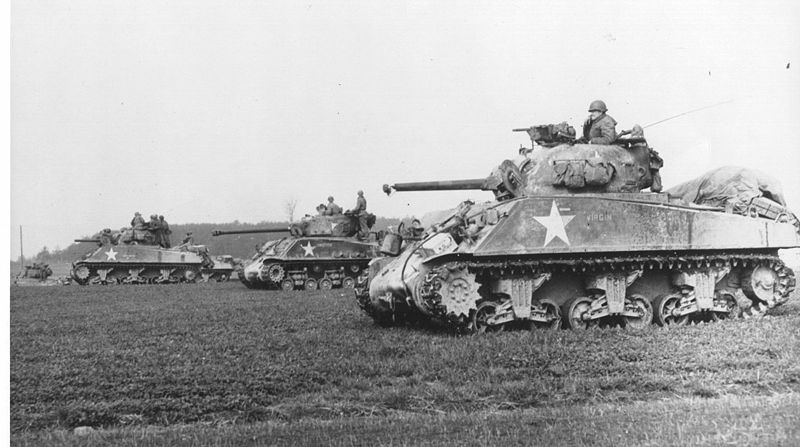
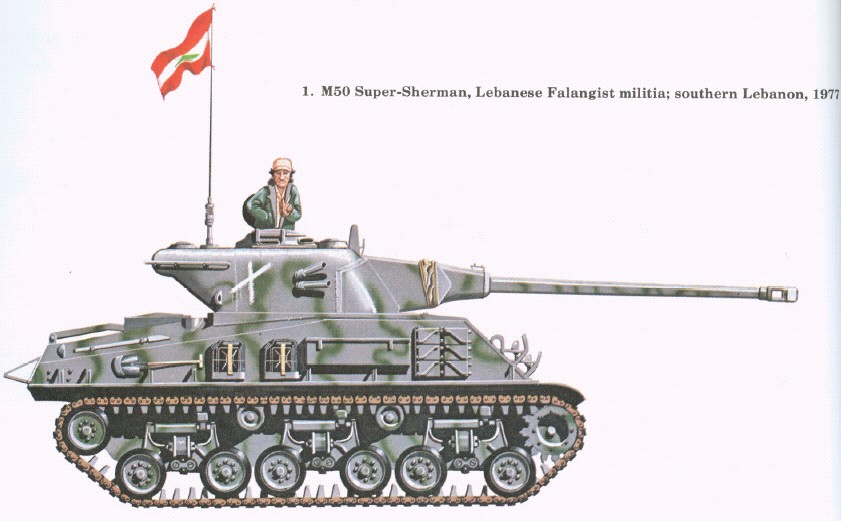
Shermans also went to Israel. The Israeli up-gunned 75mm M-50 and 105mm armed M-51 Super Shermans are remarkable examples of how a long obsolete design can be upgraded in front-line use.[45] They saw combat in the 1967 Six-Day War fighting Soviet World War II-era armor like the T34/85, and also in the 1973 Yom Kippur War, proving effective even against newer, heavier Soviet tanks like the T-54/55.
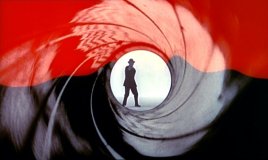 James Bond is For Real
James Bond is For Real